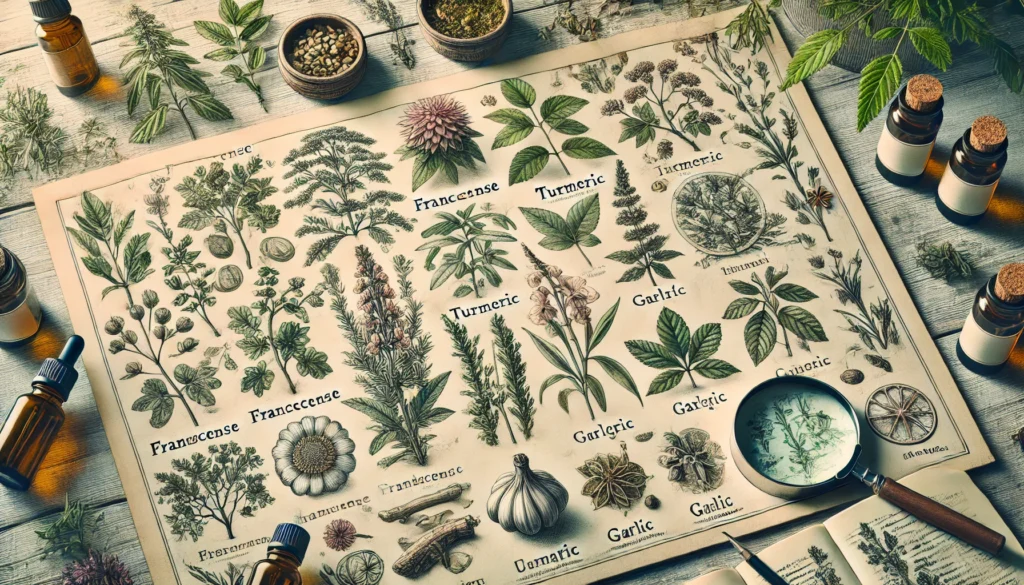Table of Contents
Frankincense: Ancient Medicine and Biblical Symbol with Modern Health Benefits
Frankincense, a resin derived from the Boswellia tree, has been revered for thousands of years for its medicinal, spiritual, and cultural significance. Its history is rich, spanning ancient Egypt, traditional medicine in the Middle East and India, and religious texts such as the Bible. In modern times, frankincense is recognized for its powerful health benefits, from reducing inflammation and supporting joint health to improving digestion and promoting relaxation.
This comprehensive guide will explore the historical and biblical importance of frankincense, its health benefits, methods of consumption, and how you can incorporate this ancient remedy into your modern wellness routine.
This site contains affiliate links, and I may receive a commission on purchases made through them. Please see our Affiliate Disclosure for more details.

Historical Significance
Ancient Use in Religious Ceremonies
Frankincense has long been associated with sacred rituals and religious ceremonies. Its use dates back over 5,000 years, with evidence suggesting it was highly prized by ancient civilizations in Egypt, Greece, Rome, and the Middle East. In ancient Egypt, frankincense was burned as incense in temples and used as an offering to the gods. The Egyptians believed the fragrant smoke carried prayers to the heavens. It was also used in the mummification process to preserve bodies for the afterlife.
In the Arabian Peninsula, frankincense played a significant role in religious and spiritual practices. It was commonly burned in temples as a way to cleanse and purify the space, as well as to enhance meditation and prayer.
Biblical and Christian Significance
Frankincense holds profound significance in the Bible, where it is mentioned numerous times as a symbol of holiness, divinity, and spiritual significance. One of the most well-known references is in the New Testament, in the story of the Magi’s visit to baby Jesus. In the Gospel of Matthew (Matthew 2:11), the Magi (or Wise Men) present Jesus with three gifts—gold, frankincense, and myrrh—each symbolizing an important aspect of Jesus’ life and mission.
- Gold symbolized Jesus’ kingship.
- Frankincense symbolized his divinity and the role of a priest.
- Myrrh symbolized his eventual suffering and death.
Frankincense was not only valuable but deeply spiritual, used in offerings to God in Jewish temple rituals as described in Exodus 30:34, where God instructed Moses to make a sacred incense of frankincense for worship in the tabernacle. This sacred incense was burned on altars as a symbol of prayer and devotion rising to heaven.
Throughout the Old Testament, frankincense is mentioned alongside other aromatic resins as a sacred ingredient in religious ceremonies, often symbolizing the connection between humanity and the divine. Its spiritual associations continue today, as frankincense is still used in Christian and other religious rituals, especially in the Eastern Orthodox Church, where it is burned during services.
Frankincense in Traditional Medicine
Beyond its spiritual significance, frankincense has a long history of use in traditional medicine systems. In Ayurvedic medicine, it is known as Shallaki and has been used for centuries to treat inflammation, digestive issues, and respiratory conditions. Similarly, in Traditional Chinese Medicine (TCM), frankincense (Ru Xiang) is used to invigorate blood circulation, reduce pain, and promote healing.
Frankincense was also used in the ancient Middle East to treat a wide variety of ailments, from arthritis to skin conditions. It was often burned to purify the air and ward off infectious diseases.

Botanical Profile
Source of Frankincense
Frankincense comes from the Boswellia tree, primarily Boswellia sacra, Boswellia carterii, and Boswellia serrata. These trees are native to arid regions of the Arabian Peninsula (especially Oman and Yemen), East Africa (especially Somalia), and India. The resin is extracted by making incisions in the tree’s bark, allowing the sap to slowly ooze out and harden into droplets, which are then harvested after a few weeks.
The resin, once dried, is either burned as incense or used to create essential oils, powders, and supplements. Each type of Boswellia has slightly different chemical compositions, but all contain compounds that contribute to frankincense’s healing properties.
Growing Conditions
Boswellia trees thrive in harsh, dry climates, where they grow in rocky soil with little water. The trees are incredibly resilient and can grow in conditions where few other plants survive. The process of harvesting frankincense is labor-intensive, as the trees must be carefully cut and the resin must be allowed to dry before collection.
Harvesting Process
The traditional method of extracting frankincense involves making shallow cuts in the bark of the Boswellia tree. Over several weeks, the sap seeps out and hardens into resin “tears,” which are then collected. The resin can vary in color, from milky white to amber or even dark brown, depending on the species of tree and the region in which it is grown.

Nutritional and Phytochemical Profile
Frankincense resin contains numerous active compounds that give it its therapeutic properties. These compounds include:
Key Active Compounds
- Boswellic Acids: The most well-known and studied compounds in frankincense, boswellic acids have potent anti-inflammatory and pain-relieving effects. They inhibit the enzyme 5-lipoxygenase (5-LOX), which is responsible for inflammation in the body. This makes frankincense particularly effective for reducing joint pain, swelling, and inflammation associated with conditions like arthritis.
- Terpenes: Terpenes are antioxidant compounds that help protect the body from oxidative stress and damage. They also contribute to frankincense’s ability to enhance immune function, reduce inflammation, and support healthy cell function.
Other Bioactive Components
In addition to boswellic acids and terpenes, frankincense contains monoterpenes and diterpenes, which have antimicrobial, mood-enhancing, and anti-cancer properties. These compounds contribute to frankincense’s effectiveness in treating a wide range of health conditions, from infections to stress and anxiety.

Health Benefits of Frankincense
Reduces Inflammation
Frankincense is widely recognized for its anti-inflammatory properties, thanks to the presence of boswellic acids. These compounds work by inhibiting inflammatory pathways in the body, making frankincense a natural remedy for conditions like osteoarthritis, rheumatoid arthritis, asthma, and inflammatory bowel diseases (IBD). Studies have shown that frankincense can reduce joint pain and swelling, improve mobility, and even protect cartilage from further damage.
In one study, patients with osteoarthritis who took frankincense supplements experienced a significant reduction in pain and improved joint function after eight weeks of treatment.
Supports Joint and Bone Health
In addition to reducing inflammation, frankincense supports joint and bone health by promoting cartilage repair and reducing the breakdown of collagen. This makes it particularly beneficial for people with osteoarthritis and rheumatoid arthritis, helping to improve joint function and reduce discomfort.
Improves Respiratory Health
Frankincense has been used for centuries to treat respiratory conditions, and modern research supports its use for improving lung function and reducing asthma symptoms. The resin’s anti-inflammatory properties help clear the airways, reduce mucus production, and make breathing easier. Frankincense may also help reduce the severity of chronic conditions like bronchitis and sinus infections.
Enhances Digestion
Frankincense has been traditionally used to treat digestive issues, including indigestion, bloating, and irritable bowel syndrome (IBS). The resin helps soothe the digestive tract, reduce inflammation, and improve the breakdown of food. It is particularly effective for those suffering from inflammatory bowel diseases like Crohn’s disease and ulcerative colitis.
In Ayurvedic medicine, frankincense has been used for centuries to promote digestive health and reduce digestive discomfort.
Immune System Support
Frankincense is a natural immune booster, promoting the production of white blood cells and helping the body fight off infections. Its antimicrobial properties make it effective against a wide range of pathogens, including bacteria, viruses, and fungi. Frankincense can also help speed up recovery from respiratory infections, such as colds and the flu.
Promotes Skin Health
Frankincense is often used in skincare products for its ability to reduce acne, scarring, and wrinkles. The resin has natural astringent properties that help tighten the skin, reduce the appearance of pores, and improve skin tone. It also promotes cell regeneration, making it beneficial for healing wounds and improving skin elasticity.
Frankincense is particularly effective for treating eczema, psoriasis, and hyperpigmentation.
Reduces Stress and Anxiety
Frankincense essential oil is widely used in aromatherapy for its calming and grounding effects. The oil can help reduce stress, alleviate anxiety, and promote relaxation, making it an excellent natural remedy for those suffering from chronic stress or insomnia. Inhaling the aroma of frankincense has been shown to lower heart rate and blood pressure, creating a sense of tranquility and well-being.
In religious rituals, the burning of frankincense is often associated with spiritual purification and meditation, helping to clear the mind and calm the spirit.
Antimicrobial Properties
Frankincense has natural antimicrobial properties, making it an effective disinfectant for wounds and infections. It can be applied
topically to help prevent infections from cuts, scrapes, and other skin injuries. The resin’s antimicrobial effects also extend to the respiratory system, where it helps combat respiratory infections and clear congestion.
Potential Anti-cancer Properties
Emerging research suggests that frankincense may have anti-cancer effects. Some studies have found that boswellic acids can inhibit the growth of cancer cells, particularly in breast, prostate, and colon cancers. While more research is needed, the initial findings are promising, suggesting that frankincense may play a role in preventing or treating certain types of cancer.

Methods of Consumption
Frankincense Essential Oil
Frankincense essential oil is the most popular form of frankincense used today. It can be used in aromatherapy by diffusing the oil or inhaling it directly for its calming effects. It can also be applied topically, diluted with a carrier oil, for skin health or to relieve pain and inflammation.
Frankincense Resin
Frankincense resin is traditionally burned as incense during religious ceremonies or meditation. Burning the resin releases a fragrant smoke that helps purify the air, reduce stress, and promote a sense of calm. The resin can also be ground into a powder and used in herbal remedies or skincare treatments.
Frankincense Supplements
Frankincense is available in supplement form, often marketed as Boswellia serrata. These supplements are commonly used to treat arthritis, digestive issues, and inflammation. The typical dosage for Boswellia extract is 300–500 mg, taken one to three times per day.
Frankincense Tinctures and Topical Use
Frankincense tinctures are liquid extracts that can be taken orally or applied to the skin. They are used to treat a variety of ailments, from digestive issues to skin conditions. When applied topically, frankincense can help heal wounds, reduce scarring, and promote healthy, youthful skin.

Cautionary Advice
Potential Side Effects
While frankincense is generally safe for most people, some may experience mild side effects, such as digestive upset, skin irritation, or allergic reactions. If applying frankincense topically, always dilute it with a carrier oil to avoid skin irritation.
Medication Interactions
Frankincense may interact with certain medications, particularly blood thinners and anti-inflammatory drugs. If you are taking any medications, it is important to consult with a healthcare provider before using frankincense supplements or essential oils.
Safe Dosage
The recommended dosage for frankincense supplements (such as Boswellia serrata extract) is typically around 300–500 mg, taken once or twice daily. Always follow the manufacturer’s guidelines and consult a healthcare provider for personalized dosage recommendations.
Pregnancy and Nursing
There is limited research on the safety of frankincense during pregnancy or breastfeeding. Pregnant or nursing women should consult with a healthcare provider before using frankincense in any form.

Conclusion
Frankincense is a powerful and versatile natural remedy with deep roots in ancient religious ceremonies, traditional medicine, and biblical history. From reducing inflammation and supporting joint health to promoting relaxation, improving digestion, and enhancing skin health, frankincense offers a wide range of health benefits that have made it a valued remedy for thousands of years.
Whether you choose to use frankincense essential oil for aromatherapy, take Boswellia supplements for joint pain, or apply it topically for skin health, this ancient resin remains a potent symbol of wellness and healing. As with any herbal remedy, it is important to use frankincense responsibly, following dosage guidelines and consulting with a healthcare provider if you have any underlying conditions or are taking medications.
